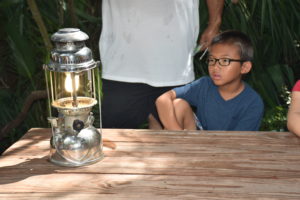Did you know there are camps at the Lighthouse? We offer camps three times per year which follow the St. Johns County Schools’ calendar during summer, winter, and spring breaks. Our camps also reach out to underserved and at-risk populations through scholarships and donations from our generous supporters. Scholarships and donations allow students to attend our camps who have high academic achievement and potential but do not have the economic means to attend. This year we also partnered with First Coast Blessings in a Backpack to ensure those students who need it would receive nutritional meals when they are not at camp. See below for more information.
Beginning May 30th, campers survived a shipwreck on Anastasia Island, immersed themselves in local folkways, tried their hand at archaeological conservation, became a tourist, and kept our light going. Whew! Each week has a different theme that brings STEAM-based learning (Science, Technology, Engineering, Art, & Mathematics) and fun to campers. Guest Speakers, field trips, science experiments, crafts, and activities bring each theme to life. Of course, there is the opportunity to climb the tower and explore our exhibits, too.
Some questions we asked the campers to consider during their first week for the theme, Shipwreck Survival:
• What is the most important thing to do when stranded?
• Would you create shelter, make fire, find water or scavenge for supplies first?
Staying dry and lessening your exposure to the elements is priority number one. Heat stroke or hypothermia would cause problems that could prevent you from being able to tackle those other necessities for survival. Other IFS (Important For Survival) skills were learned and practiced by campers to ensure the highest number of survivors possible, which for us was 100% just as expected!
Can you name all the cultural influences that shaped St. Augustine before and after its founding in 1565? Our second week aimed to do just that by inviting community members and staff to share with campers their heritage and traditions from the past. Cuban foodways, Greek culture, and Seminole clothing design are just a few of the customs with which the campers engaged. 
Some questions that arose as we learned:
• Is it hard to find the queen bee in a group of bees?
• Does using an atlatl really make a difference?
• Can I navigate from point A to point B?
The answers that we found to those questions:
• Very hard!
• Yes it really does make a difference!
• Not when it is raining unfortunately.
What do eggs and vinegar have to do with shipwreck conservation? The third week focused on the methods our Maritime Archaeological Conservationists use to process artifacts. Topics included: concretions, cleaning artifacts, preservation, casting, artifact cell absorption of salt water, non-Newtonian fluids, and the meaning of maritime archaeology. ***TRY AT HOME*** Putting an egg into vinegar for 24-36 hours removes the calcium from the shell and the outer membrane becomes “rubber-like”, while the yolk inside remains unscathed. Conservationists may use vinegar to remove the calcium in a concretion that is on a soft metal, like a coin. The concretion can be removed without scratching the metal underneath. Give the egg a try at home but be careful because the membrane can break easily. A highlight for campers was performing emergency conservation triage.
What is a spectroscope? Our campers not only learned what one is, but they made one, too. The last week of camp concentrated on the Science of Light as it relates to our Fresnel lens in the tower. Two of the topics were reflection/refraction and magnification. Our man-made lens does all three, but can you think of another natural resource that does this too? Water! A highlight for this week was seeing how a kerosene lantern worked. DID YOU KNOW? The Lighthouse went from oil to kerosene in 1885.
Are you curious about unanswered questions? Well, you know the answer to that! Come join us at the Lighthouse, visit our website www.staugustinelighthouse.org, or register for a camp to learn more. Additionally, please visit the below links to learn more about the wonderful mission of First Coast Blessings in a Backpack who helped us to make a difference this year in over half of our campers’ lives.
https://www.firstcoastblessingsinabackpack.com/home.html
https://www.facebook.com/FirstCoastBlessings/

